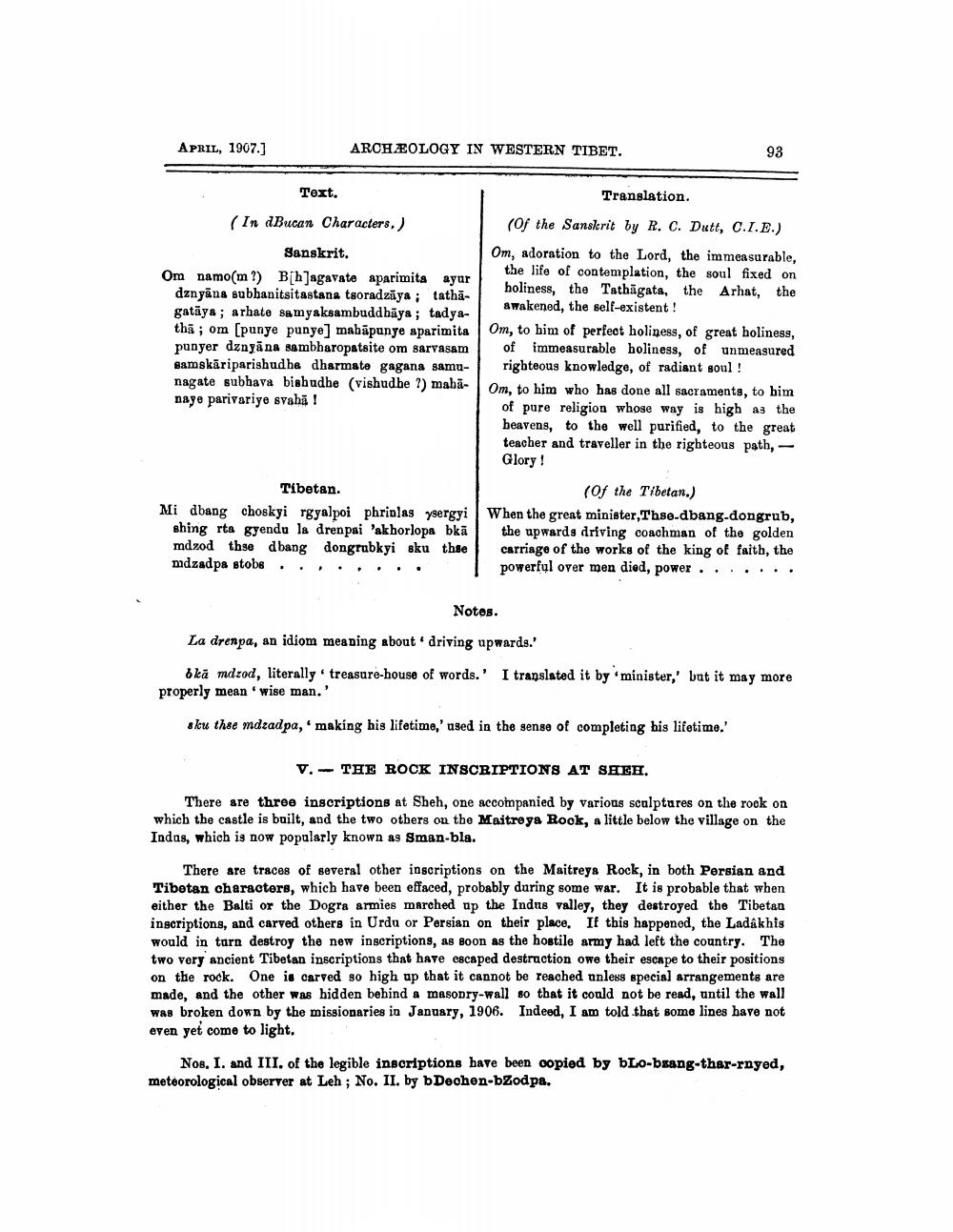________________
APRIL, 1907.]
ARCHÆOLOGY IN WESTERN TIBET.
93
Text.
Translation. (In dBucan Characters, )
(Of the Sanskrit by R. C. Dutt, C.I.E.) Sanskrit.
Om, adoration to the Lord, the immeasurable, Om namo(m?) B[h]agavate aparimita ayur
the life of contemplation, the soul fixed on dznyāna subhanitsitastana tsoradzāya ; tathā
holiness, the Tathāgata, the Arhat, the gatāya; arhate samyaksambuddhaya; tadya
awakened, the self-existent ! thā; om (punye punye] mabāpanye aparimita Om, to him of perfect holiness, of great holiness, punyer dznyāna sambharopatsite om sarvasam of immeasurable holiness, of unmeasured samskäriparishudhe dharmate gagana samu- righteous knowledge, of radiant soul! nagate subhava bishudhe (vishudhe 2) mabā- Om, to him who has done all sacraments, to him naye parivariye svaha !
of pure religion whose way is high as the heavens, to the well purified, to the great teacher and traveller in the righteous path,
Glory! Tibetan.
(Of the Tibetan.) Mi dbang choskyi rgyalpoi phrinlas ysergyi When the great minister, Thse.dbang-dongrub,
shing rta gyendu la drenpai 'akhorlopa bkā the upwards driving coachman of the golden mdzod thse dbang dongrubkyi sku thae carriage of the works of the king of faith, the mdzadpa stobs ........
powerful over men died, power .......
Notos. La drenpa, an idiom meaning about driving upwards.'
oka mdrod, literally treasure-house of words.' properly mean wise man.'
I translated it by minister,' but it may more
sku thee mdzadpa, making his lifetime,' used in the sense of completing his lifetime.'
V.
THE ROCK INSCRIPTIONS AT SHEH.
There are three inscriptions at Sheh, one accompanied by various sculptures on the rock on which the castle is built, and the two others on the Maitreya Rook, a little below the village on the Indas, which is now popularly known as Sman-bla.
There are traces of several other inscriptions on the Maitreya Rock, in both Persian and Tibetan characters, which have been effaced, probably during some war. It is probable that when either the Balti or the Dogra armies marched up the Indus Valley, they destroyed the Tibetan inscriptions, and carved others in Urdu or Persian on their place. If this happened, the Ladakhis would in torn destroy the new inscriptions, as soon as the hostile army had left the country. The two very ancient Tibetan inscriptions that have escaped destruction owe their escape to their positions on the rock. One is carved so high up that it cannot be reached unless special arrangements are made, and the other was hidden behind a masonry-wall so that it could not be read, until the wall was broken down by the missionaries in January, 1906. Indeed, I am told that some lines have not even yet come to light.
Nos, I. and III. of the legible inscriptions have been copied by bLo-baang-thar-rnyed, meteorological observer at Leh ; No. II. by b Dechen-bZodpa.




